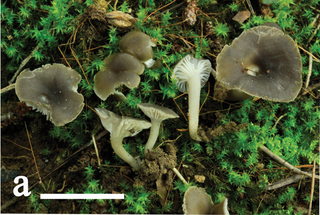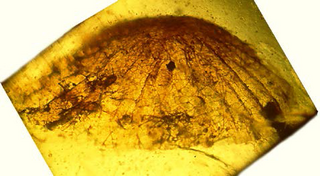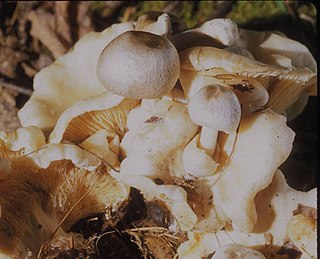
The Agaricales are an order of fungi in the division Basidiomycota. As originally conceived, the order contained all the agarics, but subsequent research has shown that not all agarics are closely related and some belong in other orders, such as the Russulales and Boletales. Conversely, DNA research has also shown that many non-agarics, including some of the clavarioid fungi and gasteroid fungi belong within the Agaricales. The order has 46 extant families, more than 400 genera, and over 25,000 described species, along with six extinct genera known only from the fossil record. Species in the Agaricales range from the familiar Agaricus bisporus and the deadly Amanita virosa to the coral-like Clavaria zollingeri and bracket-like Fistulina hepatica.

The Strophariaceae are a family of fungi in the order Agaricales. Under an older classification, the family covered 18 genera and 1316 species. The species of Strophariaceae have red-brown to dark brown spore prints, while the spores themselves are smooth and have an apical germ pore. These agarics are also characterized by having a cutis-type pileipellis. Ecologically, all species in this group are saprotrophs, growing on various kinds of decaying organic matter. The family was circumscribed in 1946 by mycologists Rolf Singer and Alexander H. Smith.

The Hygrophoraceae are a family of fungi in the order Agaricales. Originally conceived as containing white-spored, thick-gilled agarics, including Hygrophorus and Hygrocybe species, DNA evidence has extended the limits of the family, so it now contains not only agarics, but also basidiolichens and corticioid fungi. Species are thus diverse and are variously ectomycorrhizal, lichenized, associated with mosses, or saprotrophic. The family contains 34 genera and over 1000 species. None is of any great economic importance, though fruit bodies of some Hygrocybe and Hygrophorus species are considered edible and may be collected for sale in local markets.

Camarophyllopsis is a genus of agarics in the family Clavariaceae. Basidiocarps are dull-coloured and have dry caps, rather distant, decurrent lamellae, white spores, and smooth, ringless stems. In Europe species are characteristic of old, unimproved grasslands which are a declining habitat, making them of conservation concern.

The Tricholomataceae are a large family of fungi within the order Agaricales. Originally a classic "wastebasket taxon", the family included any white-, yellow-, or pink-spored genera in the Agaricales not already classified as belonging to e.g. the Amanitaceae, Lepiotaceae, Hygrophoraceae, Pluteaceae, or Entolomataceae.

The genus Stropharia is a group of medium to large agarics with a distinct membranous ring on the stipe. Well-known members of this genus include the edible Stropharia rugosoannulata and the blue-green verdigris agarics. Stropharia are not generally regarded as good to eat and there are doubts over the edibility of several species. However the species Stropharia rugosoannulata is regarded as prized and delicious when young and is now the premier mushroom for outdoor bed culture by mycophiles in temperate climates.

The Physalacriaceae are a family of fungi in the order Agaricales. Species in the family have a widespread distribution, ranging from the Arctic, (Rhizomarasmius), to the tropics, e.g. Gloiocephala, and from marine sites (Mycaureola) and fresh waters (Gloiocephala) to semiarid forests (Xerula).

Mythicomyces is a fungal genus in the family Mythicomycetaceae. A monotypic genus, it contains the single species Mythicomyces corneipes, first described by Elias Fries in 1861. The fungus produces fruit bodies with shiny yellowish-orange to tawny caps that are 1–3 cm (0.4–1.2 in) in diameter. These are supported by stems measuring 2–5.7 cm (0.8–2.2 in) long and 1–2 mm thick. A rare to uncommon species, it is found in northern temperate regions of North America and Europe, where it typically fruits in groups, in wet areas of coniferous forests. There are several species with which M. corneipes might be confused due to a comparable appearance or similar range and habitat, but microscopic characteristics can be used to reliably distinguish between them.
Limnoperdon is a fungal genus in the monotypic family Limnoperdaceae. The genus is also monotypic, as it contains a single species, the aquatic fungus Limnoperdon incarnatum. The species, described as new to science in 1976, produces fruit bodies that lack specialized structures such as a stem, cap and gills common in mushrooms. Rather, the fruit bodies—described as aquatic or floating puffballs—are small balls of loosely interwoven hyphae. The balls float on the surface of the water above submerged twigs. Experimental observations on the development of the fruit body, based on the growth on the fungus in pure culture, suggest that a thin strand of mycelium tethers the ball above water while it matures. Fruit bodies start out as a tuft of hyphae, then become cup-shaped, and eventually enclose around a single chamber that contains reddish spores. Initially discovered in a marsh in the state of Washington, the fungus has since been collected in Japan, South Africa, and Canada.

Infundibulicybe is a genus of fungi that is robustly placed incertae sedis as sister group to the Tricholomatoid clade. It has previously been part of the family of Tricholomataceae, but recent molecular phylogeny has shown it to take an isolated position within the Agaricales.

Pseudoomphalina is a genus of fungi placed in the family Tricholomataceae for convenience. The genus contains six species that are widespread in northern temperate areas. Pseudoomphalina was circumscribed by Rolf Singer in 1956. Pseudoomphalina was found to be paraphyletic to Neohygrophorus in a molecular phylogenetics study and since Pseudoomphalina is an older name, Neohygrophyorus was synonymized with it. The type species of Neohygrophorus was Neohygrophorus angelesianus, now Pseudoomphalina angelesiana. In earlier classifications based on anatomy prior to DNA sequence-based classifications, its unusual combination of features led taxonomists to independently create two subgenera in two genera: Hygrophorus subg. Pseudohygrophorus and Clitocybe subg. Mutabiles; the latter based on Neohygrophorus angelesianus but described under a new species name which is now placed in synonymy, Clitocybe mutabilis. All species of Pseudoomphalina are united by the presence of clamp-connections in their hyphae, an interwoven gill trama and amyloid spores. Pseudoomphalina angelesiana possesses grey-violaceous pigments that turn red in alkali solutions and lacks filiform, hyphal sterile elements in its hymenium and stipitipellis. These were features used to distinguish it from Pseudoomphalina as a genus, but Pseudoomphalina umbrinopurpurascens possesses these same pigments and the filiform elements of Pseudoomphalina. Molecular phylogenetics studies have also found some former species of Pseudoomphalina to belong in other genera. Pseudoomphalina pachyphylla was moved to its own genus, Pseudolaccaria, and Pseudoomphalina clusiliformis was synonymized with it. Pseudoomphalina flavoaurantia and Pseudoomphalina lignicola were found to belong in Clitocybula. Phylogenetically, Pseudoomphalina is in a tricholomatoid clade but not in the Tricholomataceae.
Episphaeria is a genus of fungus in the Agaricales. The genus is monotypic, and contains the single rare species Episphaeria fraxinicola, found in Europe. Its familial position is not known with certainty. The tiny fruit bodies of the fungus resemble minute, white cups that grow scattered or in groups on the bark of ash trees.

Flammulaster is a genus of agaricoid fungi in the family Tubariaceae. It was formerly thought to belong in the family Inocybaceae. The genus has a widespread distribution, and contains 20 species. Flammulaster was circumscribed by American mycologist Franklin Sumner Earle in 1909.

Podoserpula is a genus of fungi in the family Amylocorticiaceae. The genus contains six species including the type species, P. pusio, commonly known as the pagoda fungus. Species of the genus Podoserpula produce fruit bodies consisting of up to a dozen caps arranged in overlapping shelves, attached to a central axis. Its unique shape is not known to exist in any other fungi. The genus is known to occur in Australia and New Zealand, Venezuela, Madagascar, and New Caledonia.

Palaeoagaracites is an extinct monotypic genus of gilled fungus in the order Agaricales. It contains the single species Palaeoagaracites antiquus.

Gymnopilus maritimus is a fungus species of the family Hymenogastraceae first collected in northern Sardinia, Italy, in 2006. The species produces moderately sized, sturdy mushrooms of a reddish-orange colour. The cap, which can measure up to 70 millimetres (3 in) across, is covered in orange fibrils, and sometimes has small scales. The yellowish stem measures up to 110 mm (4 in) in length by 8 mm (0.3 in) in width, and sometimes shows remnants of the partial veil. The mushrooms have thick gills of a variable colour, ranging from yellow to rust but staining darker, and the yellow flesh has a mild taste. The mushrooms leave a rusty-brown spore print, while the spores themselves measure from 7.5–11.5 micrometres (0.00030–0.00045 in) in length. The species is most similar in appearance to G. arenophilus and G. fulgens, but can be differentiated from both morphologically. Despite the similarities, it is not closely related to either, suggesting convergent evolution. Instead, within the genus Gymnopilus, it is most closely related to the spectabilis–imperialis clade. However, it is not particularly similar to any of its closest relatives.

Volvopluteus is a genus of small to medium-sized or big saprotrophic mushrooms growing worldwide. The genus has been segregated from Volvariella with which it shares some morphological characteristics such as the presence of a volva and a pink to pink-brown spore print. Phylogenetic analyses of DNA data have shown that Volvopluteus is closely related to Pluteus and both genera currently are classified in the family Pluteaceae, while Volvariella is not closely related to either genus and its position in the Agaricales is still uncertain.

Volvariella surrecta, commonly known as the piggyback rosegill, is an agaric fungus in the family Pluteaceae. Although rare, the species is widely distributed, having been reported from Asia, North America, Northern Africa, Europe, and New Zealand. The fungus grows as a parasite on the fruit bodies of other gilled mushrooms, usually Clitocybe nebularis. V. surrecta mushrooms have white or greyish silky-hairy caps up to 8 cm (3.1 in) in diameter, and white gills that turns pink in maturity. The stipe, also white, is up to 9 cm (3.5 in) long, and has a sack-like volva at its base.

Volvopluteus michiganensis is a species of mushroom in the family Pluteaceae. It was originally described under the name Pluteus michiganensis but molecular studies have placed it in the Volvopluteus, a genus described in 2011. The cap of this mushroom is about 7–9 cm (2.8–3.5 in) in diameter, gray, and has a cracked margin that is sticky when fresh. The gills start out as white but they soon turn pink. The stipe is white and has a volva at the base. Microscopical features and DNA sequence data are of great importance for separating this taxon from related species. V. michiganensis is a saprotrophic fungus that was originally described as growing on sawdust. It has only been reported from Michigan (US) and the Dominican Republic.

Pholiota nubigena, commonly known as the gastroid pholiota or the bubble gum fungus, is a species of secotioid fungus in the family Strophariaceae. It is found in mountainous areas of the western United States, where it grows on rotting conifer wood, often fir logs. It fruits in spring, often under snow, and early summer toward the end of the snowmelt period in high mountain forests. Fruit bodies appear similar to unopened mushrooms, measuring 1–4 centimetres tall with 1–2.4 cm diameter caps that are whitish to brownish. They have a short but distinct whitish stipe that extend through the internal spore mass (gleba) of the fruit body into the cap. The gleba consists of irregular chambers made of contorted gills that are brownish in color. A whitish, cottony partial veil is present in young specimens, but it often disappears in age and does not leave a ring on the stipe.

















